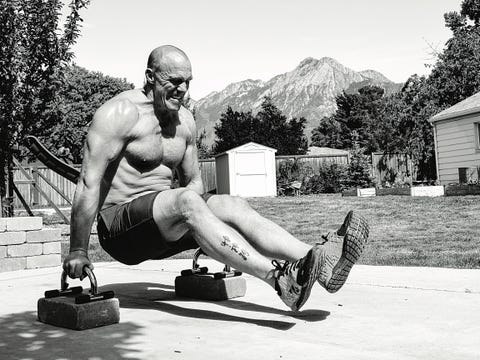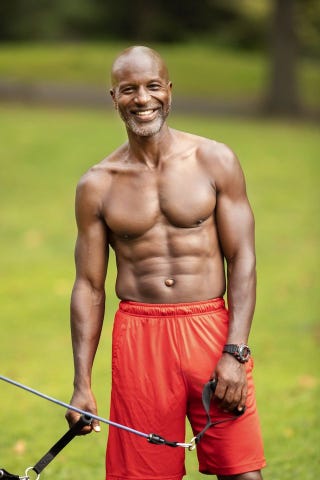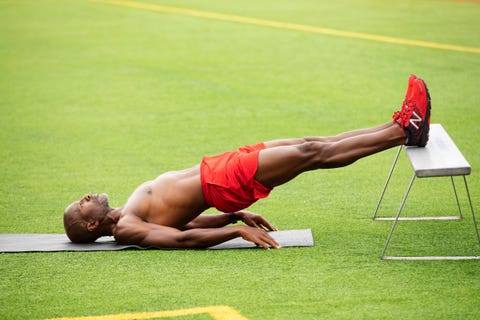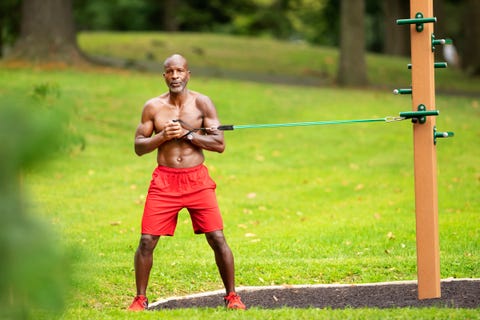No, age isn’t just a number. But it’s not a harbinger of gym doom, either. Tweak your training smartly, and even if you’re nowhere near 50, you’ll feel strong as the years go on (and on, and . . . on). Here’s your guide to eternal power.
We all know that staying in shape gets harder as you get older. But with more guys in their 50s hitting the Ironman, and other guys in their 50s and 60s looking like 20-somethings, you know your potential: You can stay in shape even as you age.
Older men continue to chase muscle. Witness MH cover guy Lenny Kravitz, who is 56 with abs that can break Instagram. Or Hugh Jackman, still deadlifting like Wolverine. Or Jason Statham (yes, he’s 53 . . . and still kicking ass).
Your own muscle quest can continue past the half-century mark, and we’ve found the elder-statesmen trainers who can show you how. Maybe you can’t endure hypertrophy hell anymore—but you’re not headed for Jazzercise and speed-walking, either. “You don’t have to change everything you’re doing,” says 47-year-old former bodybuilder Bryan Krahn, C.S.C.S., the author of Men’s Health Muscle After 40. “Just work smart.” Here’s how.
Step 1: Change Your Mindset
If you’re an older guy still approaching workouts as if you were in your 20s, you’re destined to fail. And if you’re young and already tired of tweaking joints and muscles, just you wait. Everyone can gain from making these four mental adjustments.
Dumbbells Are Your Friend
Barbell lifting is the gym gold standard, but it restricts your limbs from moving comfortably. (It’s overrated in your youth, too.). As you age, consider ditching the barbell presses for dumbbell presses, for example, since, as Krahn says, your connective tissues are losing elasticity.
Embrace Bodybuilding Moves
Total-body moves (think cleans and squats) are CrossFit mainstays, but bodybuilding-style isolation exercises like biceps curls should also be in your workouts. You’ll recover from these exercises more quickly than heavy lifts, allowing you to train more often. Do them twice a week.
Work Hard, Recover Harder
Your body can still recover from brutal workouts—with a little extra TLC. So double down on recovery time. Trainer Bobby Maximus, 42, author of the book Maximus Body, hits the spa more than the gym. Do the same. For every half hour in the gym, spend an hour foam rolling or doing easy yoga.
Set Limits on Your Training
An extra minute of burpees today isn’t worth not training tomorrow. “Your work capacity is starting to decline,” says Krahn, “along with your ability to recuperate.” So cap your sessions with a time limit(say, 45 minutes) or track total sets (12 working sets and not a single one more).
Step 2: Identify the Real Enemy
The biggest threat to staying fit comes from inside your body. Sarcopenia, the age-related loss of skeletal muscle mass, erases 3 percent to 8 percent of your muscle mass each decade starting in your 30s. But you can fight back.
Build Power
You don’t beat sarcopenia just by lifting weights to build strength, says Brad Schoenfeld, Ph.D., a veteran muscle researcher. You need to build a unique brand of strength: power.
Classic strength is your ability to lift, say, 20 pounds. Power is your ability to lift that same weight quickly. Build power training into your workouts twice weekly, using lighter weights for your exercises. Do 3 sets of 6 reps, taking 2 seconds to lower the weight and no more than 1 second to accelerate it upward.
Eat for Muscle
Training breaks down your muscles, so you need protein to rebuild. Skip that and your muscles never fully recover.
Schoenfeld recommends consuming 35 to 40 grams of protein per meal. (Try a protein shake, or 4 to 6 ounces of meat.)
“Most people,” he says, “simply don’t get sufficient protein intake.”
Step 3: Love the Little Things
The big, badass exercises (power cleans!) are fun, but it’s the little ones with nerdy names that keep you healthy. “Subtle exercises make a world of difference for injury prevention, superior conditioning, and max performance,” says trainer Kirk Charles, who’s 57. Master these three.
Elevated Hip Bridge Hold
Strengthen your hamstrings, which come into play whenever you pick up a box. Lie with your back on the ground, heels on a chair, toes pointed toward the ceiling, knees slightly bent. Tighten your core, dig your heels into the chair, and raise your hips as high as possible, or until your hips are in line with your knees and shoulders. Hold for 20 to 30 seconds, squeezing your hamstrings. That’s 1 rep; do 5 .
Pallof Press
Meet your weapon against lower-back pain. Anchor a resistance band to a post just below shoulder height. Grasp the band with both hands, arms near your chest; turn so your left shoulder faces the anchor point; and step away until the band is tight. This is the start. Tighten your core and straighten your arms in front of you; hold for 2 seconds. Return to the start. That’s 1 rep; do 3 sets of 12 to 15 per side.
Resistance Band Pull-Apart
Midback strength will protect your shoulders long-term. Stand holding a light resistance band in both hands, arms in front of you, core tight, palms facing each other, just a slight bend in your elbows. Keeping your arms parallel to the ground, rotate your arms wide, pulling the band apart, squeezing your shoulder blades. Pause, then return to the start. That’s 1 rep; do 3 sets of 15.
Step 4: Make Better Moves (& Fix the Bad Ones)
Newsflash: Your body doesn’t care that you can pull off Instagram’s wildest exercise hits (and your happy-hour buddies don’t, either). Build muscle and stay healthy by relying on safe movements—and modifying some riskier ones, too.
3 Moves to Love
Romanian Deadlift
Not everyone has the hip mobility to deadlift from the ground. Romanian deadlifts help. Start standing, holding weight at your hips, then slowly lower your torso and push your butt back.
Floor Press
This offers the same chest-development upside as dumbbell and barbell bench presses while delivering greater protection for your shoulders.
Hollow Hold
This gymnastics staple has you lying on your back, lower back pressed into the ground, legs and shoulder blades off the ground. That builds all-around core strength.
3 Moves to Tweak
Max-Height Box Jump
Box jumps develop lower-body explosiveness, but set the box 10 inches lower than your max.
Wide-Grip Pullup
Opt for neutral-grip pullups instead, with hands slightly wider than shoulder width, protecting your shoulders from long-term injury.
Barbell and Dumbbell Military Press
Most lifters lack the shoulder mobility to press overhead. Opt for land-mine presses instead, allowing your arms to move slightly in front of your torso.
A version of this story originally appears in the November 2020 issue of Men’s Health.
Source: Read Full Article










